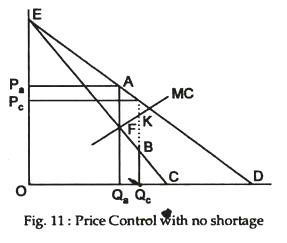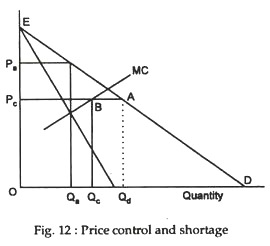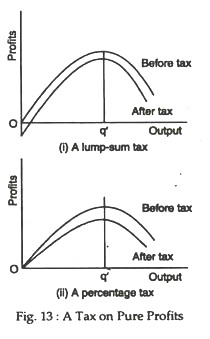The following points highlight the two main ways for controlling monopoly. The ways are: 1. Price Control 2. Taxes.
Way # 1. Price Control:
One suggested approach is for the regulatory agency to set the price that the monopolist can charge and allow consumers to purchase the amount they wish at that price.
An important difference between the effects of price control in perfect competition and monopoly is that in a monopoly situation price control does not necessarily lead to shortages. The point is illustrated in Fig.11. Here the line EAD is the demand (average revenue) curve and EBC is the marginal revenue curve.
In the absence of price control the profit-maximising monopolist fixes its equilibrium output Q0 by equating its MC with MR (as is indicated by point F). Now suppose the government fixes the maximum price of Pc for the output of the monopolist. This means that the monopolist can now sell Qc units at this price (as is indicated by the demand curve EAD).
ADVERTISEMENTS:
Now the MR curve will be the broken line PcABC (rather than EFBC) because the monopolist can now sell Qc units at the legal maximum price. In fact, the segment AB is actually a discontinuity on the new (post-control) MR curve. And the MC curve can pass through any point, in the range AB. In this diagram it passes through point G.
This means that for outputs less than Qc, MR (- Pc) is greater than marginal cost. So the monopolist gains by increasing output from Q0 to Qc. However, if the monopolist wants to sell more than Qc, MR curve is given by the segment BC of the original marginal revenue curve, EEBC.
In other words, if the monopolist wants to sell more than Qc units its MR will be less than BQc. It is so because the price cut needed to sell additional output must be applied to the output Qc also, which could be sold at the legal maximum price Pc.
ADVERTISEMENTS:
However, if the monopolist wants to sell less than Qc units, its MR (= Pc) will be greater than MC. So the monopolist can increase the size of its profits by increasing output over this range. For any output level beyond Qc, MC >MR. So the monopolist will lose by producing and selling more than Qc units.
Thus, it is clear that when the price ceiling (of Pc) is imposed the monopolist’s profit-maximising level of output is Qc. This price has induced the monopolist to increase output. So there is no shortage at this output level.
However, Fig. 11 does not indicate the whole truth. In some monopoly situations price ceilings may create shortages. Fig. 12 illustrates such a possibility. When the ceiling price is fixed much below the original equilibrium price (Pc here), the MR curve becomes Pc AQD. The MC curve intersects the MR curve at point B. So the monopolist will now offer only Qc units at this price which is also equal to MR. But at that price consumers will be willing to buy and ready to pay for Qd units. So there will be shortage amounting to QcQd and some illegal means will develop to pay extra price to acquire the limited amount of the commodity which is available.
Way # 2. Taxes:
We may alternatively suggest that governments impose taxes of various kinds on monopolies.
ADVERTISEMENTS:
A tax on total profits leaves equilibrium price and output unchanged.
In both parts of Fig. 13, the upper curve shows how profits vary with output before the imposition of the tax. The profit-maximising output is q’. The lower curve shows how profits vary with output after the imposition of a tax.
In part (i), we see that there is a fixed tax on profit. Consequently, every point on the upper curve shifts down exactly by the amount of tax. The profit-maximising output remains unchanged at q’.
In part (ii), we see the effect of a profit tax of 20%. Every point on the lower curve is 20% less than the corresponding point on the upper curve. The profit-maximising level of output remains unchanged at q’.


